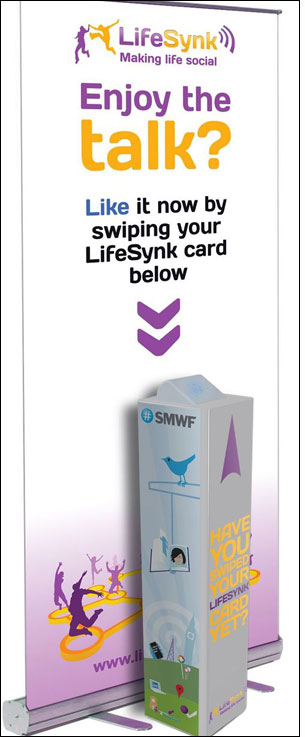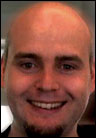British startup LifeSynk Ltd. is launching an RFID solution intended to bring brick-and-mortar stores, the products they sell, and events such as conferences to the Internet, via consumers and their Facebook accounts. The system, which includes low-frequency (LF) or high-frequency (HF) RFID cards and readers, as well as a cloud-based server to manage read data, aims to serve retailers, product suppliers and organizers of conferences or other events. Retailers can offer promotions to customers who use the technology to “share” their store visits with Facebook friends. For product marketers, a consumer can tap his or her card near a reader while buying a particular product, thereby gaining a discount or other benefit, while also updating his or her Facebook status to indicate what was purchased. In the case of a conference, festival or concert, the technology can be used similarly, enabling ticket holders to “like” a band or speaker, or to simply share what they are doing with friends, thereby obtaining discounts, credits or contest eligibility.
LifeSynk Ltd. is currently in discussions with several firms—primarily marketers of brand-name companies—about how to utilize the technology to promote their products. What’s more, the company is providing the technology to a conference in London, to be held later this month.

Late last year, LifeSynk Ltd. spun off from Gamaroff Digital, a British firm launched in 2008 to provide social-media marketing software platforms. Gamaroff Digital, which provides marketing software via Facebook, identified the value of RFID technology for granting businesses greater prominence on Facebook via their customers’ “likes” at physical locations. As a result, says Mike Gamaroff, the president and CEO of both Gamaroff Digital and LifeSynk, the latter firm was developed to provide the RFID solutions. LifeSynk can use RFID technology from a variety of vendors, Gamaroff says, and is currently evaluating several companies’ products. Initially, the LifeSynk system will operate with LF RFID cards, though the company plans to offer a version that employs HF RFID technology complying with the Near Field Communication (NFC) standards. The long-term goal, he says, is to allow consumers to use their NFC-enabled mobile phone to access promotional information, coupons and loyalty points, while sharing their “likes” on Facebook, by tapping the phone against reader stations.
At present, the LifeSynk solution consists of the RFID cards, as well as terminals with a built-in RFID reader, a computer and a Wi-Fi connection to LifeSynk’s cloud-based server, using its software platform to link a read event with the specific user’s Facebook or other social-media account. The system also manages data, such as the number of times that a particular retailer or product was “liked,” and the number of friends of those Facebook users who then clicked on Web sites to learn more.
The solution, Gamaroff explains, is intended to link physical locations with the Internet connections available on Facebook or Twitter. The company worked for several months to develop the NFC-enabled solution, he says, before LifeSynk was officially launched in October 2011.
With the solution in place, brand owners or retailers will provide cards at retail locations, and the same card could be employed at multiple sites. For example, it could be used at a fitness center to indicate when a user was exercising (the card holder could then gain loyalty points toward receiving a reward). At a store, LifeSynk could be utilized to indicate on the customer’s Facebook account that he or she was purchasing a specific product, along with the reward (such as a discount) that the individual was receiving. It could also be used at sporting events or concerts, Gamaroff adds.
The RFID cards are manufactured for LifeSynk by a third-party provider. The card comes with an EM Microelectronic EM4100 RFID chip, and can be printed with a store or product logo, as well as instructions explaining how to use the card. What’s more, it displays a LifeSynk URL and a serial number. A user who wishes to participate can use a Web browser on his or her smartphone to log onto the Web site, enter the card’s serial number and then press a prompt indicating agreement with linking the use of the card with that person’s Facebook account. The user will then be asked to provide his or her Facebook account ID and password. (Facebook privacy settings can be set to indicate that the individual does not wish to share specific information with all or only particular friends.)
At a store, for example, a consumer can walk up to the reader terminal and present the card, as instructed by signage. The card’s unique ID number will be read and transmitted via a Wi-Fi connection to LifeSynk’s software, which will then forward the store-related information to that individual’s Facebook account, in order to post a status update, such as that the person is visiting the store, purchasing a specific product or “liking” something at that location. If several participating brands were sold at a single store, one reader terminal would be dedicated to each brand. When the user presented his or her card, the software would link the card’s unique ID with the brand linked to that person’s account in the system. The benefit for stores and brand owners, the company reports, is visibility on online social networks, while consumers benefit from the rewards provided by the vendors or brand owners.
Later this month, thousands of visitors at the Socialmedia Worldforum (SMWF) Europe conference, taking place in London, will be able to utilize the LifeSynk system to identify the speakers they like, and to compete in a game at a coffeehouse that will qualify them for a drawing to receive a month’s worth of free coffee.
Approximately 4,000 visitors are expected to attend the Socialmedia Worldforum conference, all of whom will be able to participate in the LifeSynk program if they so choose. The conference will employ three LifeSynk terminals stations. Two will be installed at the doorway to theaters in which speakers will offer presentations throughout the conference. LifeSynk software is programmed with the schedule for those presenters, in order to track responses to each speaker at each location. The system will then enable a competition among speakers, with the presenter who gains the most “likes” from attendees named the winner. Upon attending a presentation, a visitor can simply walk up to the reader station and present the card as instructed, and the card’s unique ID number will be sent to LifeSynk’s software via a Wi-Fi connection, and then be forwarded to the individual’s Facebook account, to post the “like” status for that particular speaker on the attendee’s account.
A third station, to be installed at a coffee vendor site at the conference, will require that users participate in a game involving finding another attendee to qualify as a possible winner of a month’s worth of free coffee.
One challenge at conferences, Gamaroff says, involves encouraging visitors to network among each other. The game is intended to provide that opportunity. First, a user can taps the card at the station, thus enabling the LifeSynk software to connect that individual to his or her Facebook account, and also linking that visitor to another individual who previously presented an RFID card to the reader. The system will display that other attendee’s picture (that person’s Facebook profile photo) and name, and the user will then be challenged to locate that individual, obtain his or her business card and take it to a LifeSynk kiosk. Upon accomplishing that task, the visitor can take the business card to workers at the LifeSynk kiosk, who will then read that person’s RFID card. The software will display the name of the individual whom the attendee was challenged to locate, and LifeSynk’s staff will then compare that name against the one on the business card. If there is a match, the visitor’s name will be added to the drawing for a month’s worth of free coffee.
The company is also in discussions with event organizers for a music festival scheduled to take place later this year in the United Kingdom. In this case, the reader stations could be used to enable attendees to “like” specific bands.
Early customers of the LifeSynk system receive a first-year lease discount, Gamaroff says. However, he notes, the cost of the system varies according to the volume of readers and card users.


